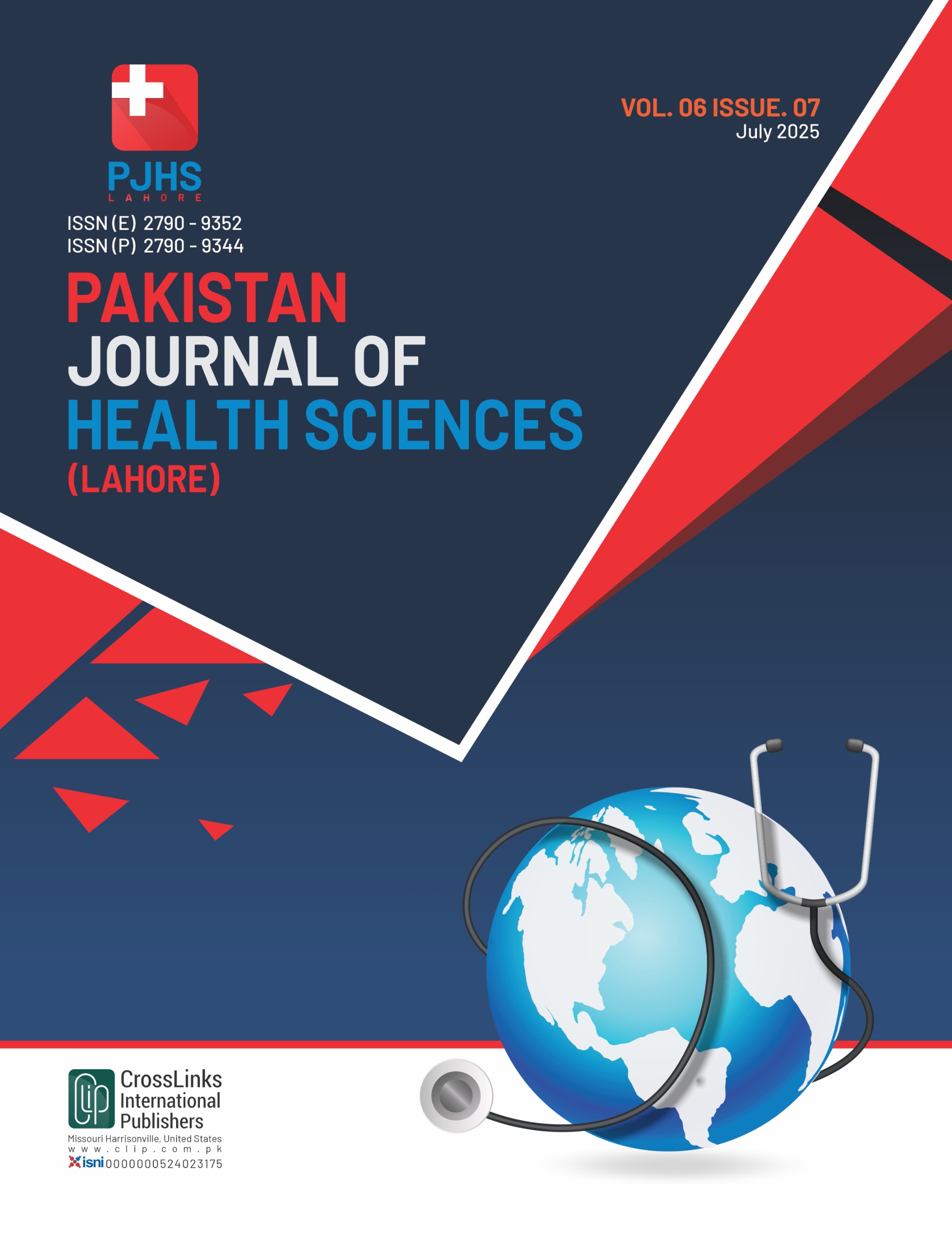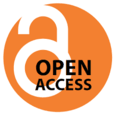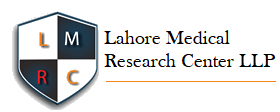Comparison of Frequency of Postpartum Haemorrhage in Augmented Versus Spontaneous Labour
Postpartum Haemorrhage in Augmented Versus Spontaneous Labour
DOI:
https://doi.org/10.54393/pjhs.v6i7.3268Keywords:
Postpartum Haemorrhage, Spontaneous Labour, Augmented Labour, Normal vaginal delivery, HypertensionAbstract
Postpartum haemorrhage (PPH) remains a major cause of maternal morbidity and mortality. Labour augmentation is commonly practiced but may increase the risk of excessive bleeding. Objectives: To determine the frequency of PPH and compare its occurrence in spontaneous versus augmented labour. Methods: A descriptive cross-sectional study was conducted at the Department of Obstetrics and Gynaecology, Mardan Medical Complex, from August 2023 to January 2024. A total of 151 women aged 18–40 years with singleton pregnancies at ≥36 weeks were enrolled using non-probability consecutive sampling. Data on age, parity, gestational age, hypertension, socioeconomic and residential status, labour type, and PPH were collected through a structured proforma. PPH was defined as blood loss >500 ml within 24 hours of vaginal delivery. Data were analyzed using SPSS version 25.0, and associations were tested using Chi-square and Fisher’s exact tests. Results: The frequency of PPH was 13.2%. PPH occurred more frequently in spontaneous labour (15.7%) compared to augmented labour (10.3%), though this was not statistically significant (p=0.333). A significant association was found between hypertension and PPH (p=0.017), with hypertensive women showing a higher risk. Conclusions: It was concluded that Hypertension was significantly associated with postpartum haemorrhage, underscoring the importance of careful monitoring. Labour augmentation did not significantly increase PPH risk. Ongoing evaluation of maternal risk factors is crucial for improving outcomes.
References
Tiruneh B, Fooladi E, McLelland G, Plummer V. Incidence, Mortality, and Factors Associated with Primary Postpartum Hemorrhage Following in-Hospital Births in Northwest Ethiopia. PLOS One. 2022 Apr; 17(4): e0266345. doi: 10.1371/journal.pone.0266345. DOI: https://doi.org/10.1371/journal.pone.0266345
Gustiani R and Kartini F. Factors Affecting Postpartum Haemorrhage on Postpartum Mother. Placentum: Jurnal Ilmiah Kesehatan dan Aplikasinya. 2023; 11(1): 13-22. doi: 10.20961/placentum.v11i1.55528. DOI: https://doi.org/10.20961/placentum.v11i1.55528
Nigussie J, Girma B, Molla A, Tamir T, Tilahun R. Magnitude of Postpartum Hemorrhage and Its Associated Factors in Ethiopia: A Systematic Review and Meta-Analysis. Reproductive Health. 2022 Mar; 19(1): 63. doi: 10.1186/s12978-022-01360-7. DOI: https://doi.org/10.1186/s12978-022-01360-7
Kalu FA and Chukwurah JN. Midwives’ Experiences of Reducing Maternal Morbidity and Mortality from Postpartum Haemorrhage (PPH) In Eastern Nigeria. BioMed Central Pregnancy and Childbirth. 2022 Jun; 22(1): 474. doi: 10.1186/s12884-022-04804-x. DOI: https://doi.org/10.1186/s12884-022-04804-x
Liu CN, Yu FB, Xu YZ, Li JS, Guan ZH, Sun MN et al. Prevalence and Risk Factors of Severe Postpartum Hemorrhage: A Retrospective Cohort Study. BioMed Central Pregnancy and Childbirth. 2021 Apr; 21(1): 332. doi: 10.1186/s12884-021-03818-1. DOI: https://doi.org/10.1186/s12884-021-03818-1
Majeed S, Tahira T, Younis Z, Usman S. Maternal Mortality and Morbidity Associated with Primary PPH in Patients at Allied Hospital Faisalabad. Indus Journal of Bioscience Research. 2025 Apr; 3(4): 38-42. doi: 10.70749/ijbr.v3i4.820. DOI: https://doi.org/10.70749/ijbr.v3i4.820
Zeng Y, Zhang Y, Zhen M, Lao L, Ma Y, Liu L et al. Side-Effects of Oxytocin in Postpartum Hemorrhage: A Systematic Review and Meta-Analysis. American Journal of Translational Research. 2022 Mar; 14(3): 1934.
Jones AJ, Federspiel JJ, Eke AC. Preventing Postpartum Hemorrhage with Combined Therapy Rather Than Oxytocin Alone. American Journal of Obstetrics and Gynaecology Maternal Fetal Medicine. 2023 Feb; 5(2): 100731. doi: 10.1016/j.ajogmf.2022.100731. DOI: https://doi.org/10.1016/j.ajogmf.2022.100731
Jamil S, Majeed T, Naureen R, Sheraz MA, Sikandar MZ. Incidence of Postpartum Hemorrhage in Induced Versus Normal Labour. Pakistan Journal of Medical and Health Sciences. 2023; 17(08): 57-57. doi: 10.53350/pjmhs202317857. DOI: https://doi.org/10.53350/pjmhs202317857
Khadim I, Hussain N, Sahar N, Khalid R. Effect of Nursing Care Practices Based on Clinical Interventions on the Incidence of Primary Post-Partum Hemorrhage in Females Undergoing Spontaneous Vaginal Delivery: Nursing Care Practices Based on Clinical Interventions. Pakistan Journal of Health Sciences. 2023 Apr: 161-5. doi: 10.54393/pjhs.v4i04.657. DOI: https://doi.org/10.54393/pjhs.v4i04.657
Rafiq S, Ali S, Bashir H, Karim S, Mateen A, Zia S. Comparison of the Frequency of Postpartum Hemorrhage in Induced Labour and Spontaneous Labour in Pregnant Women. The Professional Medical Journal. 2023 Oct; 30(10): 1264-9. doi: 10.29309/TPMJ/2023.30.10.7669. DOI: https://doi.org/10.29309/TPMJ/2023.30.10.7669
Bernitz S, Betran AP, Gunnes N, Zhang J, Blix E, Øian P et al. Association of Oxytocin Augmentation and Duration of Labour with Postpartum Haemorrhage: A Cohort Study of Nulliparous Women. Midwifery. 2023 Aug; 123: 103705. doi: 10.1016/j.midw.2023.103705. DOI: https://doi.org/10.1016/j.midw.2023.103705
Cheng TS, Zahir F, Solomi C, Verma A, Rao S, Choudhury SS et al. Does Induction or Augmentation of Labor Increase the Risk of Postpartum Hemorrhage in Pregnant Women with Anaemia? A Multicenter Prospective Cohort Study in India. International Journal of Gynaecology and Obstetrics. 2025 Apr; 169(1): 299-309. doi: 10.1002/ijgo.16008. DOI: https://doi.org/10.1002/ijgo.16008
Kumar B, Kumari S, Hughes S, Savill S. Prospective cohort study of induction of labor: Indications, outcome and postpartum hemorrhage. European Journal of Midwifery. 2021 Nov; 5: 53. doi: 10.18332/ejm/142782. DOI: https://doi.org/10.18332/ejm/142782
Mentzoni CT, Klungsøyr K, Engjom HM. Trends in severe postpartum haemorrhage among nulliparous women with spontaneous onset of labour: A population‐based cohort study. An International Journal of Obstetrics and Gynaecology. 2024 Oct; 131(11): 1475-83. doi: 10.1111/1471-0528.17838. DOI: https://doi.org/10.1111/1471-0528.17838
Khurshid S, Khurshid M, Khan F. Incidence of Primary Postpartum Haemorrhage in Induced Versus Augmented Labour. A One Year Review at FMH. 2023.
Zhu H, Lu D, Branch DW, Troendle J, Tang Y, Bernitz S et al. Oxytocin Is Not Associated with Postpartum Hemorrhage in Labor Augmentation in A Retrospective Cohort Study in the United States. American Journal of Obstetrics and Gynaecology. 2024 Feb; 230(2): 247-e1. doi: 10.1016/j.ajog.2023.07.054. DOI: https://doi.org/10.1016/j.ajog.2023.07.054
Pettersen S, Falk RS, Vangen S, Nyfløt LT. Exploring Trends of Severe Postpartum Haemorrhage: A Hospital-Based Study. BioMed Central Pregnancy and Childbirth. 2023 May; 23(1): 363. doi: 10.1186/s12884-023-05702-6. DOI: https://doi.org/10.1186/s12884-023-05702-6
Girault A, Blondel B, Fraser W, Goffinet F, Le Ray C. Maternal and Neonatal Consequences of Early Augmentation of Labor Among Women with Spontaneous Onset of Labor: A National Population‐Based Study. Birth. 2025 Jun; 52(2) :308-19. doi: 10.1111/birt.12883. DOI: https://doi.org/10.1111/birt.12883
Mubasher S, Syed S, Malik SN, Ishtiaq A, Bilqis H, Noreen H. Comparison of Frequency of Postpartum Hemorrhage in Spontaneous versus Prostaglandin Induced Labour at Term Gestation. Life and Science. 2024 Aug; 5(3): 08-. doi: 10.37185/LnS.1.1.618. DOI: https://doi.org/10.37185/LnS.1.1.618
Ladfors LV, Liu X, Sandström A, Lundborg L, Butwick AJ, Muraca GM et al. Risk of Postpartum Hemorrhage with Increasing First Stage Labor Duration. Scientific Reports. 2024 Sep; 14(1): 22152. doi: 10.1038/s41598-024-72963-2. DOI: https://doi.org/10.1038/s41598-024-72963-2
Pacagnella RC, Borovac‐Pinheiro A, Silveira C, Siani Morais S, Argenton JL, Souza JP et al. The Golden Hour for Postpartum Hemorrhage: Results from A Prospective Cohort Study. International Journal of Gynaecology and Obstetrics. 2022 Mar; 156(3): 450-8. doi: 10.1002/ijgo.13823. DOI: https://doi.org/10.1002/ijgo.13823
Thies-Lagergren L, Kvist LJ, Gottvall K, Jangsten E. A Swedish Register-Based Study Exploring Primary Postpartum Hemorrhage in 405 936 Full-Term Vaginal Births Between 2005 and 2015. European Journal of Obstetrics and Gynaecology and Reproductive Biology. 2021 Mar; 258: 184-8. doi: 10.1016/j.ejogrb.2020.12.018 DOI: https://doi.org/10.1016/j.ejogrb.2020.12.018
Downloads
Published
How to Cite
Issue
Section
License
Copyright (c) 2025 Pakistan Journal of Health Sciences

This work is licensed under a Creative Commons Attribution 4.0 International License.
This is an open-access journal and all the published articles / items are distributed under the terms of the Creative Commons Attribution License, which permits unrestricted use, distribution, and reproduction in any medium, provided the original author and source are credited. For comments













